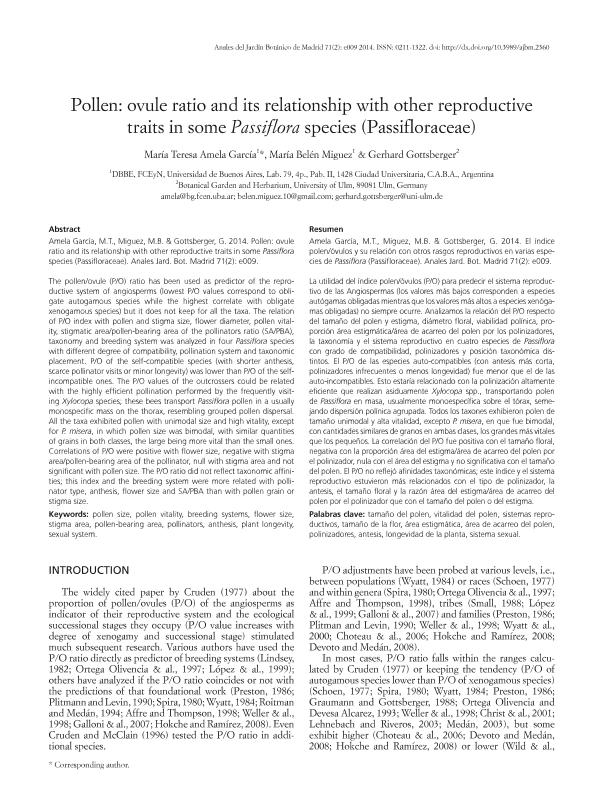Mostrar el registro sencillo del ítem
dc.contributor.author
Amela Garcia, Maria Teresa

dc.contributor.author
Miguez, María Belén

dc.contributor.author
Gottsberger, Gerhard
dc.date.available
2017-05-30T19:49:06Z
dc.date.issued
2014-12
dc.identifier.citation
Amela Garcia, Maria Teresa; Miguez, María Belén; Gottsberger, Gerhard; Pollen: ovule ratio and its relationship with other reproductive traits in some Passiflora species (Passifloraceae); Consejo Superior de Investigaciones Científicas; Anales del Jardín Botánico de Madrid; 71; 2; 12-2014; 1-8
dc.identifier.issn
0211-1322
dc.identifier.uri
http://hdl.handle.net/11336/17124
dc.description.abstract
The pollen/ovule (P/O) ratio has been used as predictor of the reproductive system of angiosperms (lowest P/O values correspond to obligate autogamous species while the highest correlate with obligate xenogamous species) but it does not keep for all the taxa. The relation of P/O index with pollen and stigma size, flower diameter, pollen vitality, stigmatic area/pollen-bearing area of the pollinators ratio (SA/PBA), taxonomy and breeding system was analyzed in four Passiflora species with different degree of compatibility, pollination system and taxonomic placement. P/O of the self-compatible species (with shorter anthesis, scarce pollinator visits or minor longevity) was lower than P/O of the self-incompatible ones. The P/O values of the outcrossers could be related with the highly efficient pollination performed by the frequently visiting Xylocopa species; these bees transport Passiflora pollen in a usually monospecific mass on the thorax, resembling grouped pollen dispersal. All the taxa exhibited pollen with unimodal size and high vitality, except for P. misera, in which pollen size was bimodal, with similar quantities of grains in both classes, the large being more vital than the small ones. Correlations of P/O were positive with flower size, negative with stigma area/pollen-bearing area of the pollinator, null with stigma area and not significant with pollen size. The P/O ratio did not reflect taxonomic affinities; this index and the breeding system were more related with pollinator type, anthesis, flower size and SA/PBA than with pollen grain or stigma size.
dc.description.abstract
La utilidad del índice polen/óvulos (P/O) para predecir el sistema reproductivo de las Angiospermas (los valores más bajos corresponden a especies autógamas obligadas mientras que los valores más altos a especies xenógamas obligadas) no siempre ocurre. Analizamos la relación del P/O respecto del tamaño del polen y estigma, diámetro floral, viabilidad polínica, proporción área estigmática/área de acarreo del polen por los polinizadores, la taxonomía y el sistema reproductivo en cuatro especies de Passiflora con grado de compatibilidad, polinizadores y posición taxonómica distintos. El P/O de las especies auto-compatibles (con antesis más corta, polinizadores infrecuentes o menos longevidad) fue menor que el de las auto-incompatibles. Esto estaría relacionado con la polinización altamente eficiente que realizan asiduamente Xylocopa spp., transportando polen de Passiflora en masa, usualmente monoespecífica sobre el tórax, semejando dispersión polínica agrupada. Todos los taxones exhibieron polen de tamaño unimodal y alta vitalidad, excepto P. misera, en que fue bimodal, con cantidades similares de granos en ambas clases, los grandes más vitales que los pequeños. La correlación del P/O fue positiva con el tamaño floral, negativa con la proporción área del estigma/área de acarreo del polen por el polinizador, nula con el área del estigma y no significativa con el tamaño del polen. El P/O no reflejó afinidades taxonómicas; este índice y el sistema reproductivo estuvieron más relacionados con el tipo de polinizador, la antesis, el tamaño floral y la razón área del estigma/área de acarreo del polen por el polinizador que con el tamaño del polen o del estigma.
dc.format
application/pdf
dc.language.iso
eng
dc.publisher
Consejo Superior de Investigaciones Científicas

dc.rights
info:eu-repo/semantics/openAccess
dc.rights.uri
https://creativecommons.org/licenses/by-nc-sa/2.5/ar/
dc.subject
Pollen Size
dc.subject
Pollen Vitality
dc.subject
Breeding Systems
dc.subject
Flower Size
dc.subject.classification
Ciencias de las Plantas, Botánica

dc.subject.classification
Ciencias Biológicas

dc.subject.classification
CIENCIAS NATURALES Y EXACTAS

dc.title
Pollen: ovule ratio and its relationship with other reproductive traits in some Passiflora species (Passifloraceae)
dc.type
info:eu-repo/semantics/article
dc.type
info:ar-repo/semantics/artículo
dc.type
info:eu-repo/semantics/publishedVersion
dc.date.updated
2017-05-02T18:16:44Z
dc.journal.volume
71
dc.journal.number
2
dc.journal.pagination
1-8
dc.journal.pais
España

dc.journal.ciudad
Madrid
dc.description.fil
Fil: Amela Garcia, Maria Teresa. Consejo Nacional de Investigaciones Científicas y Técnicas. Oficina de Coordinación Administrativa Ciudad Universitaria. Instituto de Micología y Botanica. Universidad de Buenos Aires. Facultad de Ciencias Exactas y Naturales. Instituto de Micología y Botanica; Argentina. Universidad de Buenos Aires. Facultad de Ciencias Exactas y Naturales. Departamento de Biodiversidad y Biología Experimental; Argentina
dc.description.fil
Fil: Miguez, María Belén. Universidad de Buenos Aires. Facultad de Ciencias Exactas y Naturales. Departamento de Biodiversidad y Biología Experimental; Argentina
dc.description.fil
Fil: Gottsberger, Gerhard. Universitat Ulm; Alemania
dc.journal.title
Anales del Jardín Botánico de Madrid

dc.relation.alternativeid
info:eu-repo/semantics/altIdentifier/url/http://rjb.revistas.csic.es/index.php/rjb/article/view/419
dc.relation.alternativeid
info:eu-repo/semantics/altIdentifier/doi/http://dx.doi.org/10.3989/ajbm.2360
Archivos asociados
